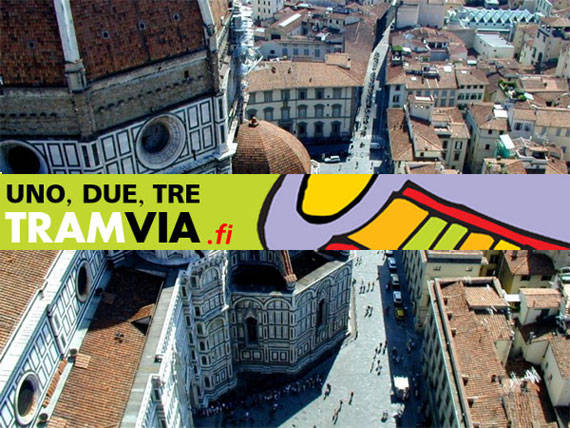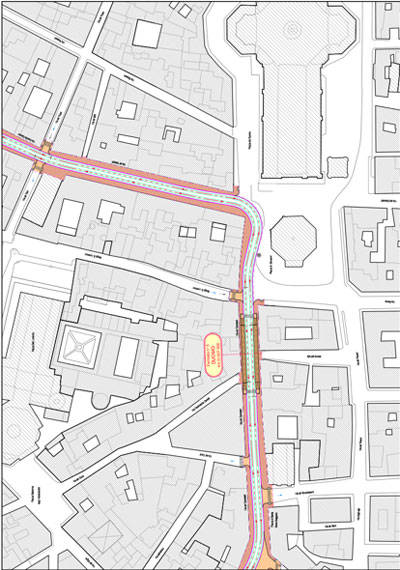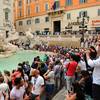Florence. A Streetcar Named Disaster?
FLORENCE – Walking to an appointment in Florence on Thursday, we found ourselves in snarled and snarling traffic. A mini-Cooper had parked badly by Piazza della Repubblica, blocking a big city bus, unable to turn a corner. The bus had come to a stop, blocking the entire city center. Police arrived. People gathered. Tourists took photos. Meantime traffic fumes, hurtling scooters, honking cars, and frustrated Florentines all built into a crescendo of misery.
Yes, it was just one of the usual urban messes, but with a difference: this is Florence, birthplace of the Italian Renaissance, one of the most elegant cities in the world, and currently one of the most troubled over traffic.
On February 18 Florentines turned out to vote on a controversial referendum over construction of Line 2 of a light railway line improperly called a “tram.” This Line 2, which in some areas would require steel tubes 21 feet high, would bring the tram line along the road—visible in the photo taken before the street was given bus lanes and barriers—between the Baptistery and the Duomo building and the file of Renaissance buildings on the right.
In an open letter to one of the most important Italian cultural websites, www.patrimoniosos.it, Florentine citizen Niccolò Fani wrote:
“Line 2 calls for the tram to cross right in front of the Baptistery and Duomo, two world-class masterpieces of art. The tracks would run within three feet of the Baptistery, which dates from before the year 1000, but is still standing nevertheless—at least up to now. Besides the aesthetic damage to Piazza Duomo (including the electric wires and bulky steel supports for the line), there are serious structural risks deriving from having a tram line so close to the buildings.”
Among the arguments in favor of the so-called “tramvia” (and those in favor of it include labor unions, coop associations and some “greens”) is that it 2,000 buses a day already go by. It will reduce the smog that discolors the white marble of the Duomo; will reduce vibrations from the heavy buses; will reduce congestion and will, miraculously at the same time, also double the number (today 250,000) of people who presently come into downtown Florence every weekday, with the consequent economic advantages. Besides, the argument goes, many of those now opposing the light train favored it in the past and are doing an undignified about-face.
Those opposing the light train argue that it has been presented as a tram, whereas it is not; that a mini-subway beneath Florence would accomplish the same goals without running tracks past Duomo and Baptistery; that an outlying stretch of the same larger plan for three connected lines has already had a gigantic cost over-run; and that it is as ugly as sin, in a city whose very essence is beauty.
And so the two sides are lined up against each other. Mario Razzanelli, a local politician and successful businessman, has been battling against the tram project for nine years and was one of the chief promoters of the referendum. He does not intend to give up his campaign.
“My battle against the tram in Florence began in 1999. This tram will not solve the problem—it will complicate the situation. It’s a battle between people who love Florence and those who would destroy it, a battle between reason and folly.” “All great cities have subways under their buildings,” one young man protested.
Another opposing the construction is the distinguished Prof. Antonio Paolucci, the recently appointed director of the Vatican Museums. A native of Florence, Paolucci is former Minister of Culture for Italy and former superintendent of archaeology for Florence, and also the author of a book on the Baptistery. Paolucci has never been a conservative, but in opposing the construction of a train line through the heart of Florence, he alienated many on the left because the conservatives of Alleanza Nazionale, who include Razzanelli, also opposed construction.
But then so did every single Florentine with whom I spoke, from travel agent to student, tobacconist, shop keeper—and the younger they were, the stronger their opposition. There is no doubt that the chaos and smog raise hackles, and feelings ran understandably high, to put it mildly. “Florence on the verge of a nervous breakdown over the tram,” went one headline.
So, to the vote. The press agency Adnkronos gave the figures: those voters opposing construction were 53.84% while 48.3% were in favor. That seems clear enough: the citizens voted to block the tram. But it did not work that way, for less that 50% of those entitled to vote turned out at the polls, and so the supporters of construction claim they had won even though those voting demonstrated their desire to block it. Here too there are quarrels: the mayor insists that the referendum must respect national criteria, which set a 50% turnout treshold for a referendum to be valid; the opponents of the tram say that local referenda go by different rules and that hence they won.
One element that has been ignored until now is that the tram would also alter the destiny of Florence’s tiny Victorian-era Protestant cemetery, in which many prominent English writers are buried, including Elizabeth Barrett Browning and Frances Trollope. The cemetery lies on a small knoll rising just outside the line where Florence’s city walls ran until demolished to make way for a broad avenue of heavy traffic. Until recently to reach it—and it is a favorite of tourists from all over the world—meant risking your life. Today zebra stripes make it at least possible, but the proposed tram would entirely cut off this romantic vestige of all those Florentine rooms with views.






































i-Italy
Facebook
Google+
This work may not be reproduced, in whole or in part, without prior written permission.
Questo lavoro non può essere riprodotto, in tutto o in parte, senza permesso scritto.